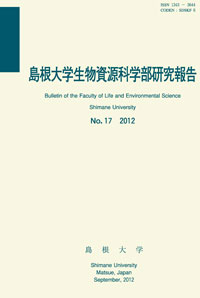島根大学生物資源科学部
ISSN:2435-0885(オンライン)
ISSN:1343-3644(冊子体)
なお、冊子体の刊行は23巻まで
ISSN:1343-3644(冊子体)
なお、冊子体の刊行は23巻まで

ダウンロード数 : ? 件
この文献の参照には次のURLをご利用ください : https://ir.lib.shimane-u.ac.jp/51413
島根大学生物資源科学部研究報告 25
2020-09-30 発行
Antifungal activity of leaf extracts from several buckwheat varieties against plant pathogenic fungi
内容記述(抄録等)
Common buckwheat (Fagopyrum esculentum) and tartary buckwheat (F. tataricum) is a commonly grown food crop in Japan. The classic Japanese work on agriculture, Nihon Nousho Zenshu, mentions that extracts of buckwheat leaves were used to control rice blast in the Edo Period. Recently, we evaluated whether the characteristics associated with infection and fungal growth of rice blast fungus, Magnaporthe oryzae, the causal agent of rice blast disease, could be suppressed by using extracts of buckwheat leaves. However, it remains unclear whether leaf extracts of several buckwheat variety would show similar inhibitory activity against other plant-pathogenic fungi. In the present study, we evaluated the broader fungicidal activity of extracts of leaves of several buckwheat varieties against the pathogens Ceratocystis fimbriata, Cochliobolus miyabeanus, Corynespora cassiicola, Fusarium buharicum, and M. oryzae. We found that an ethyl acetate extract of common buckwheat leaves (cv. Harunoibuki, cv. Kitawasesoba, and cv. Shinano 1 gou), and tartary buckwheat leaves (F. tataricum: Dattansoba) significantly inhibited conidial germination of C. fimbriata, C. miyabeanus, C. cassiicola, F. buharicum, and M. oryzae. The ethyl acetate extract of common buckwheat leaves (cv. Harunoibuki, cv. Kitawasesoba, and cv. Shinano 1 gou), and tartary buckwheat leaves (Dattansoba) were shown to have fungicidal activity against C. fimbriata, C. miyabeanus, C. cassiicola, F. buharicum, and M. oryzae. These results suggest that fungicidal substances from the leaf extracts of common buckwheat and tartary buckwheat may be a promising source for the development of new chemical fungicides to prevent plant diseases caused by fungal pathogens.
About This Article
Other Article
